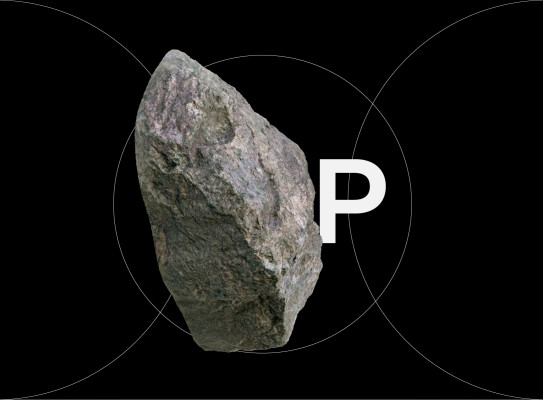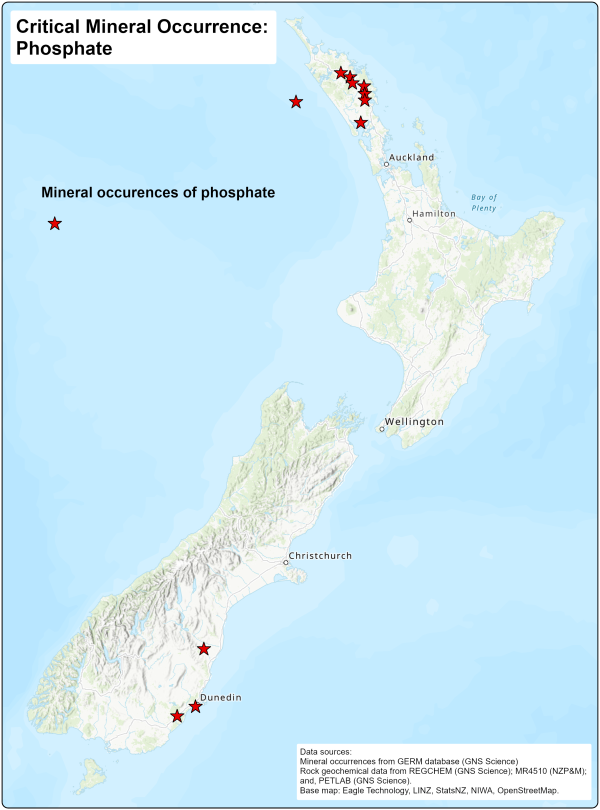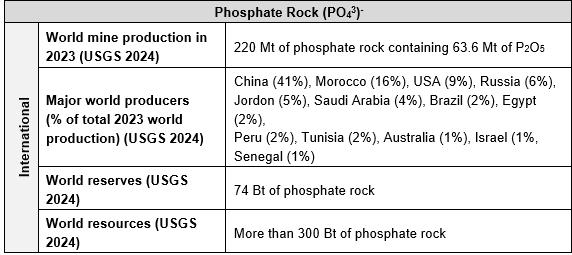Phosphate

Phosphorus, primarily found as phosphate minerals, is a fundamental element for life on Earth. It plays a critical role in biological systems, agriculture, and industry. However, phosphate resources are also of significant geological and economic interest.
Phosphate in New Zealand
Phosphate-rich beds are present at Clarendon, south of Dunedin. The 40-m-thick glauconitic Clarendon Sand of Early Miocene age occur near both its base and top. The Clarendon deposit and also other prospects in North Canterbury, South Canterbury and Waitaki are being explored. Clarendon produced about 140,000 t (25% P₂O₅) during 1920–1924, and a further 53,000 t between 1942 and 1944, for use as a fertiliser. There has been no production since 1944.
Phosphate is used to make superphosphate fertiliser by dissolving phosphate rock in sulfuric acid. New Zealand has two superphosphate manufacturing companies, Ballance Agri-Nutrients and Ravensdown Fertiliser Co-op, which operate a total of four plants across them.
Recent exploration at Claredon by L&M Mining has indicated that the drilled areas (1/25th of the deposit) contain a resource of 1.6 Mt of phosphate ore, with an average grade of 18% P₂O₅.
New Zealand imports about 680,000 t of phosphate annually, mostly (~60%) from Morocco. These imports could potentially be substituted by local production from onshore phosphate deposits (e.g. Clarendon) or offshore Chatham Rise phosphorite nodules. There is potential for a combined phosphate and glauconite operation at Clarendon, provided suitable processes and markets can be developed.
The Chatham Rise phosphorite deposits have an inferred mineral resource totalling 80 Mm³ at an average grade of 290 kg/m³ and a cut-off grade of 100 kg/m³ for a total contained 23.4 Mt of phosphorite. The phosphorite is suggested to have an average grade of 18–19% P₂O₅ (of screened material). The average thickness of the resource is 0.20 m. The resource has an E–W extent of 60 km and N–S extent of 10–30 km. A mining permit was granted to Chatham Rock Phosphate (CRP) in December 2013 for a duration of 20 years but, in February 2015, New Zealand’s Environmental Protection Agency turned down CRP’s application for an environmental consent to begin mining. CRP is yet to re-apply.

Why is Phosphate Critical
-
Essential for Life and Biochemical Processes
- A key component of DNA and RNA, phosphate enables genetic information storage and transmission.
- Forms adenosine triphosphate (ATP), the primary molecule for energy transfer in cells.
- Vital for cell membrane structure in the form of phospholipids.
-
Agriculture and Food Security
- Phosphate-based fertilisers support global food production by replenishing essential nutrients in soils.
- Essential for plant growth and root development, ensuring high agricultural yields.
-
Human and Animal Health
- Critical for bone and teeth formation, as it combines with calcium to form hydroxyapatite.
- Involved in pH balance and metabolism, supporting enzyme function and physiological processes.
-
Industrial and Technological Uses
- Used in detergents, food additives, and pharmaceuticals.
- Key in metal processing and corrosion inhibition.
Geological and Economic Importance of Magmatic Phosphate Deposits
Phosphate is primarily sourced from sedimentary and igneous deposits, with sedimentary phosphorites being the dominant global source. These deposits form under specific geological conditions that concentrate phosphorus over millions of years.
Major Deposit Types
-
Sedimentary Phosphorite Deposits (The Dominant Source)
- Formed in marine environments through the accumulation of organic matter, often associated with upwelling zones rich in nutrients.
- Typically occur as layered deposits in continental margins, such as those found in Morocco, the US, China, and Jordan.
- Composed mainly of carbonate-fluorapatite (CFA), also called francolite, a variety of fluorapatite (Ca₅(PO₄)₃F) that contains carbonate substitutions.
-
Phosphate Deposits
- Found in association with carbonatites and alkaline complexes, where phosphorus is concentrated through magmatic processes.
- Examples include deposits in Russia, Canada, and Brazil.
- Generally lower in volume than sedimentary sources but can have higher-grade material.
- Dominated by fluorapatite (Ca₅(PO₄)₃F), which crystallises directly from magma.
-
Guano and Biogenic Phosphate Deposits
- Formed from the accumulation of bird or bat guano, which undergoes diagenesis to form high-grade phosphate rock.
- Found in coastal and island environments (e.g., Nauru and Peru).
- These are of minor economic importance but historically significant.
- Primarily composed of variscite (AlPO₄·2H₂O) and other aluminium or calcium phosphates. Hydroxyapatite forms over time as guano undergoes diagenetic alteration.
-
Seafloor Phosphate Nodules (Potential Future Resource)
- Fluorapatite forms in microcrystalline aggregates.
- Often rich in trace elements like vanadium (V), uranium (U), and rare earth elements (REEs).
- Associated minerals include iron-manganese oxides, carbonates, and clays.
- Key Deposits: Chatham Rise (New Zealand), Peru Margin, Namibia Shelf.
Critical Supply and Economic Significance
- Phosphate is a non-substitutable resource for agriculture, making it geopolitically significant.
- The largest reserves are controlled by a few countries, notably Morocco and Western Sahara, which hold over 70% of the world’s known reserves.
- Many phosphate-rich countries restrict exports to secure domestic supply, leading to concerns over long-term availability.
- Environmental challenges, such as mine tailings and potential contamination from trace elements (e.g., cadmium, uranium), impact resource sustainability.
Exploration and Sustainable Development
- Modern phosphate exploration focuses on resource efficiency and alternative sources, including recycling phosphorus from waste streams.
- Advances in beneficiation technology are improving recovery from lower-grade deposits.
- Future supply challenges may drive increased interest in seafloor phosphate nodules, though economic and environmental hurdles remain.

Additional Reading
MacFarlan DAB, Barry JM. 1991. Mineral resources of New Zealand. Wellington (NZ): Ministry of Commerce, Energy and Resources Division. 61 p. Resource information report 11.
Manhire D, Ford S, Moriarty A, Manhire J. 2024. Final report: the viability, feasibility, and environmental effects from using New Zealand sourced phosphate. [Christchurch] (NZ): National Science Challenges, Our Land and Water. https://ourlandandwater.nz/wp-content/uploads/2024/03/Final-Sustainable-Phosphate-Futures-report-1.pdf(external link)
Thompson BN. 1989. Non-metallic minerals. In: Kear D, editor. Mineral deposits of New Zealand. Parkville (AU): Australasian Institute of Mining and Metallurgy. p. 15–23. (Australasian Institute of Mining and Metallurgy monograph series; 13).
Wood RA, Falconer R. 2016. Chatham phosphate: a strategic resource. In: Christie AB, editor. Mineral deposits of New Zealand: exploration and research. Carlton (AU): Australasian Institute of Mining and Metallurgy. p. 517–522. (Australasian Institute of Mining and Metallurgy monograph series; 31).